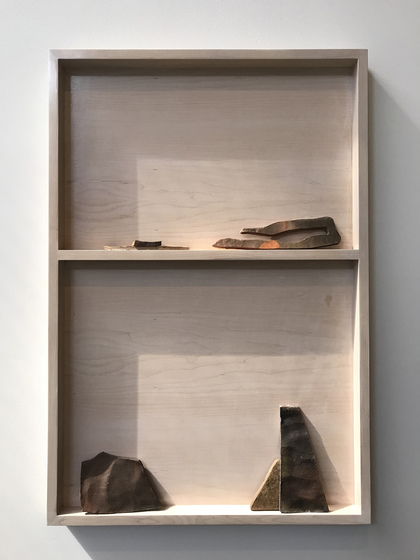-
From Current Issue
-
- Editor’s Letter Fire in the Heart
- Reviews I Gusti Ayu Kadek Murniasih
- Reviews 11th Seoul Mediacity Biennale: “One Escape at a Time”
- Dispatch Networked China
- One on One Monira Al Qadiri on Yukio Mishima
- Essays The rise of independent art spaces in pandemic-era Shanghai
- Features Tuan Andrew Nguyen
- Table of Contents
- Web Exclusives
- Archive
- Subscribe

R
E
V N
E
X
T
Installation view of MAIA LYNCH’s “In Between” at the Museum of Fine Arts, Boston, 2018. Photo copyright Museum of Fine Arts, Boston. All images courtesy Museum of Fine Arts, Boston.
On the second floor of the Museum of Fine Arts, Boston, what appeared to be shards of broken pottery lay scattered across an unadorned dais. Characterized by rust-like colors resulting from iron-rich clay and markings from wood-burning kilns, the pieces resembled artifacts found at an archaeological site. Many of the odds and ends seemed to have no formal arrangement. Yet slivers placed side by side—roughly from longest to shortest—revealed their creator’s deliberate hand. The installation Drawing from Kochi (2018) by artist Maia Lynch stood out as the most expansive among the otherwise contained works of “In Between.”
Lynch, who studied painting at the School of the Museum of Fine Arts (SMFA) at Tufts University, transposes her fascination with fragmentary shapes from the canvas to the kiln in her solo exhibition. As a recipient of the SMFA Traveling Fellowship, the American-born painter opted to return to her mother’s birthplace of Shikoku, Japan, where she had previously visited as a child. During her residency at the Togei Center, Lynch learned to make bizen ware on the site of an ancient kiln—one of six known for producing the pottery, which gained prominence in the 16th century.
Rather than craft whole vessels, such as jars or vases, Lynch molds what look like discarded pieces, or unsalvageable parts of a whole. She has said that seeing a mountain of ceramic shards, which had accumulated over time near a now dormant kiln, initially inspired the fragmented forms that seem unearthed from a bygone era. Given the generations-old technique she applied to their creation in Drawing from Kochi, the bizen stoneware remain connected to the past even as they represent a mere shadow of it—for the past can never fully be recaptured or reproduced. Physically, Lynch’s work sat in an undefined area between the institution’s substantial Japanese art collection and the Linde Family Wing for Contemporary Art, further underlining its “in-betweenness.”
Lynch’s foray into ceramics signifies a convergence not only between one side of her heritage and her hyphenated Japanese-American identity, but also with her training as a painter. Her eye for color emerges in the vibrant hues of the animation Boulder (2011/2018), displayed on a screen behind the ceramics. Accompanied by a meditative soundtrack of gongs and singing bowls, moving illustrations show the contours of a mountainside parting, hands reaching, what might be rain falling or grains of rice sticking to each other. Broken shapes also materialize in the video, drawing a through-line of recurring fragments across different mediums.
Lynch demonstrates a continued devotion to traditional techniques in painting, as well as in pottery-making. While in Japan, she also studied with contemporary Nihonga artists, who influenced her work. The wall opposite from the installation and video featured six paintings alongside two wooden shelves containing more bizen stoneware pieces. In choosing to compose the stoneware within these framed boxes, Lynch places the three-dimensional objects in direct dialogue with the two-dimensional works on paper. For instance, a “U” shape—what could be the prongs of a tuning fork—seen as a ceramic shard in Summer, 2016, Imbe (2016–18) reappears as a dark orange curve in Matsuyama Sanbancho (Third Street) (2017). In the abstract work named for a neighborhood in a city located in Ehime Prefecture, Lynch paints shadows under pumpkin-colored triangles, giving the otherwise flat forms an illusion of dimension that furthers their mirroring of the bizen stoneware. She repeats this method throughout her paintings.
By focusing on the fragment as both an object and a shape, Lynch commemorates the disparate parts of her cultural identity. On the one hand, the works’ appearance of incompleteness alludes to a degree of mourning or nostalgia for what may be buried in the past. At the same time, their meditative quality reflects an acceptance for that ongoing process of recovery. “In Between” suggests a liminality in terms of cultural and historical space, where oppositional states of being are never quite reconciled but may form something new.
Mimi Wong is a New York desk editor of ArtAsiaPacific.
Maia Lynch’s “In Between” is on view at the Museum of Fine Arts, Boston, until September 16, 2018.
To read more of ArtAsiaPacific’s articles, visit our Digital Library.





